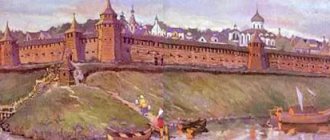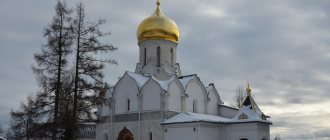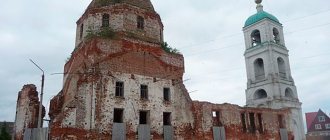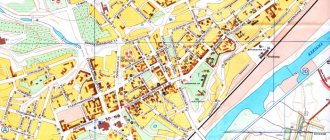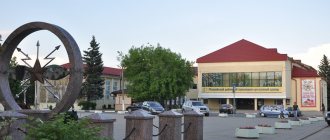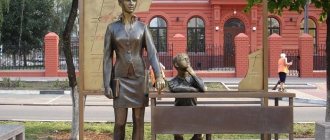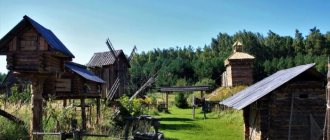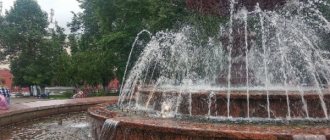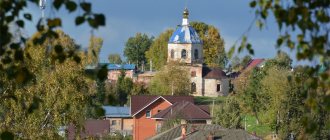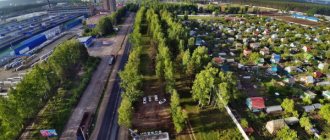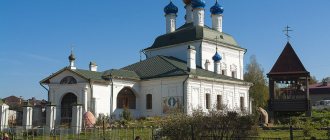Excursions in Vladimir | Booking apartments in Vladimir |
Vladimir is the city where, for many, the Golden Ring of Russia begins (or ends, depending on which end you start from). On the territory of Vladimir there are three monuments from the UNESCO World Heritage List:
- Golden Gate
- Cathedral of the Assumption of the Blessed Virgin Mary
- Cathedral of Demetrius of Thessalonica.
When planning Vladimir on your route, you need to take into account that the city can be seen in 1 day (in extreme cases, half a day is the most important), but another half day should be left for visiting Bogolyubov and Pokrov on the Nerl. So I advise you to plan at least 2 nights and 1.5-2 days in Vladimir, so as not to run around, but to get everything done calmly. We'll figure out what to see in Vladimir in 1 day, how to get there and where to go around the area.
UNESCO heritage in the city of Vladimir
The history of Vladimir as the capital of Rus' began not in the city itself, but 10 km from it - in Bogolyubovo, where in 1155 the horses carrying the icon of the Mother of God from Kyiv suddenly stopped. The night spent in prayer served as a revelation for Prince Andrei Bogolyubsky and became a turning point in the history of Vladimir-on-Klyazma. The Mother of God commanded to leave her image in this city. Since 1160, the icon began to be called Vladimir, and the city itself turned into the capital. Prince Andrey spared no expense and effort in its arrangement: three architectural masterpieces of the 12th century in Vladimir itself are today included in the list of UNESCO World Heritage Sites.
Where to go
As already mentioned, in Vladimir itself there are three monuments from the UNESCO List, and in total 8 architectural monuments were included among the masterpieces of the Vladimir-Suzdal Principality. All of them are located in the Vladimir region, and you can explore them either independently or on an excursion.
The remaining five monuments from the UNESCO list:
- Church of the Intercession on the Nerl
- Chambers of Andrei Bogolyubsky
- Suzdal Kremlin
- Monastery of Saint Euthymius
- Church of Boris and Gleb in Kideksha
Accordingly, we plan trips to the following places in the region (see the links for what to see and how to get to these places):
- Suzdal
- Bogolyubovo and Pokrova-on-Nerl
- Kideksha
- Moore
- Alexandrov
- Kirzhach
- Kolchugino
- Borisovskoye (merchants' mansion)
- Poretskoye (water mill)
- Entire (temple-tower)
- Shekshovo
- Yaryshevo
- Yuriev-Polsky
- Nebyloe (monastery)
- Podolets (temple from the times of Ivan the Terrible)
- Gorokhovets
- Gus-Khrustalny.
You can build your own route, or you can trust a guide. Details here .
Assumption Cathedral - the main temple of Vladimir Rus'
The cathedral for the miraculous icon was erected on the bank of the Klyazma River in 1158. The temple was built according to Byzantine canons, but Russian craftsmen added a unique flavor to the external design and created a masterpiece. The building stands out with its dazzling whiteness against the background of the surrounding nature.
Nowhere else, except in Zalesskaya Rus', were temples built from white stone - it was a very expensive and labor-intensive material to process. In height, the Assumption Cathedral surpassed all buildings in Rus', including the St. Sophia Cathedrals of Kyiv and Novgorod. The upward thrust was reinforced by architectural techniques: pilasters - vertical relief strips separating monolithic facades; zakomars are semicircular ends of the walls. The arcature belt, high loophole windows, golden domes, crowned with snow-white carved drums add elegance and lightness to the building.
For interior decoration, Prince Andrei invited the best craftsmen of Europe, but the main treasure of the Assumption Cathedral was the miraculous icon of Our Lady of Vladimir. She consecrated with her presence the temple, the throne city, and all of North-Eastern Rus'. In 1395, when danger loomed over the new capital, the shrine left Vladimir and settled in Moscow.
The Assumption Cathedral survived several fires; in 1238, the Tatar-Mongols set it on fire along with its inhabitants - people suffocated in the smoke, but the cathedral survived. Andrei Rublev had a hand in its revival; on the western wall of the temple there is a fresco of the Last Judgment, painted by him.
Assumption Cathedral and observation deck. View from below.
A captivating view of the Russian expanses opens from the observation deck of the Assumption Cathedral: the ancient city of Vladimir here conducts an inaudible conversation with the heart of each of its guests. Nearby there is a monument to Prince Vladimir the Red Sun. Chronicles mention that in 990 the Baptist of Rus' founded a city on the banks of the Klyazma River and named it after himself. And the great-grandson Vladimir Monomakh in 1108 fortified the city with fortress walls and built the Detinets Kremlin, this place is located east of the Assumption Cathedral.
Demetrius Cathedral - Vsevolod's house church Big Nest
From the Assumption Cathedral, a path leads through Lipki Park to the temple in honor of the Great Martyr Dmitry of Thessaloniki, the patron saint of Prince Vsevolod Yuryevich. The single-domed Dmitrievsky Cathedral was built in the 90s of the 12th century - only the prince’s family prayed here. In the external decoration we find all the techniques of architecture of North-Eastern Rus', but the most remarkable of them is the stone carving on the facades of the cathedral.
The walls of the cathedral have three tiers. The lower one is smooth; during the life of Prince Vsevolod, the lower part was occupied by galleries and flights of stairs, along which one could climb and view the scenes of the upper tiers. The middle part of the walls is occupied by an arcature belt, separating the earthly part of the temple from the heavenly part, filled with symbolic scenes.
Demetrius Cathedral in Vladimir
The southern facade is covered with details of the popular medieval legend “The Ascension of Alexander the Great”; on the opposite northern wall, Prince Vsevolod himself is depicted with his “big nest” - five sons. The carving on the western side commemorates the labors of Hercules.
In all plots there is the figure of King David the psalmist. According to some researchers, the carvings of the Demetrius Cathedral are a grandiose illustration of the 150th Psalm of David, “Let every breath praise the Lord.” Lions in this stone poem symbolize state power, birds symbolize family life, fantastic animals personify the essence of the spiritual world. Contemplation of the marvelous temple gives aesthetic pleasure to many generations of Russian people and delights foreigners.
Beaches
City Beach
On the opposite bank of the Klyazma from the city. To get there, you need to choose the direction to the Murom highway, towards Zagorodny Park, and turn left immediately after the bridge. Walking distance from the center - 25 minutes.
Equipped beach. There are translucent changing cabins, a shower, a washbasin, a toilet and a volleyball court, and food.
Sand pits near Ulybyshevo
By car: road to Ulybyshevo, one quarry is about 5 kilometers after the Southern Bypass junction, the other is 7-8 kilometers later.
Amazing nature (huge water area, sandy beach and clear water) there is a cafe nearby. The beach is not equipped, so don’t be surprised to see mounds of garbage in the forest. But what air. If you arrive early, you can grab one of the parking lots with a wooden table and benches. But every year the reservoir does not pass inspection, so swimming there is officially prohibited.
Lake Semyazino
To get there you need to turn off the M-7 highway (turn to the village of Semyazino) and drive no more than a kilometer.
Safe and equipped beach. Changing cabins, benches, sunscreens, volleyball court. There is even a rescue station and first aid station.
Cathedral Square
The space in front of the iconic churches is organized into Cathedral Square. The atmosphere of the Middle Ages is combined with the flavor of a provincial town of the 18th-19th centuries and the tastes of the Soviet era.
- In the center of the square stands a monument to the 850th anniversary of the city of Vladimir ; it symbolizes three directions of the life of the city: struggle, creativity, labor. A warrior sitting at the monument looks at the Golden Gate; the architect's gaze is focused on the Assumption Cathedral; the worker faces the industrial area of the city. The bronze figures and the entire monument give the impression of heaviness and staticity, especially against the backdrop of the elegant monuments of the 12th century. Maybe that’s why the city residents gave the monument the nickname “Three Lazy People.”
- The image of Andrei Rublev - sophisticated and spiritual - organically fit into the temple ensemble of Cathedral Square. Moscow sculptor O.K. Komov worked on this monument for 20 years; it became the artist’s swan song.
- “Chambers” - a long yellow building in a classical style seems completely out of place between two snow-white cathedrals. Another name for “Chambers” is Public Places. The building was built at the end of the 18th century by decree of Catherine the Second to organize city government. For about 200 years, it was dominated by a bureaucratic spirit, but in 1990, the residents of Vladimir managed to oust officials from the Chambers and organize museum exhibitions in them. On the ground floor, children get acquainted with the “Outpost of the Heroes”, “Land of Toys”, “Fun Fair”. On the second floor, the exhibition “Charm of Bygone Days” recreates the atmosphere of life in ancient noble estates. On the third floor there is an art gallery of paintings by Russian artists: icons of the 13th century, beautiful paintings by Shishkin, Aivazovsky, Vasnetsov.
Chambers. Exhibition “Charm of Bygone Days”
Advice. No matter which direction you approach Vladimir from, start getting to know him on Cathedral Square. Her examination will take 1-3 hours.
City Flea Markets
Eidos - second-hand bookstore
st. Bolshaya Moskovskaya house 20
Here are books for all senses, thick and thin, sad and beautiful! You can find literature that you have been looking for for a long time, you can stumble upon something that you did not expect to find, but there are also books here that you may never find anywhere else.
Yours-Mine
st. Maiden's house 3
Garage sale store. Here, any resident can rent a shelf for himself, so the most unexpected things await buyers: those with experience and completely new ones. Clothes, toys, souvenirs, hand made are whispering in the store.
Flea market "Shalopaevka"
Open on weekends from 10:00 to 15:00 at the Eidos site. st. B. Moskovskaya, house 20.
What an amazing affection they have for city flea markets! Kittens, galoshes, home china and antiques at the largest and most interesting flea market.
Bolshaya Moskovskaya street in the city of Vladimir
Cathedral Square faces Bolshaya Moskovskaya Street, the historical thoroughfare of Vladimir. And here, as in a fairy tale: if you go to the right, you will find the Ancient City; if you go to the left, you will find the Golden Gate. Bolshaya Moskovskaya has a length of 1.7 km. During the time of Andrei Bogolyubsky, it went from the Golden Gate on the western outskirts to the Silver Gate in the east of the city. In the 18th century, the street was called Bolshoi and was lined with red brick buildings, which even today give Vladimir the flavor of a provincial town of past centuries.
Pechersk city
The direction to the right from Cathedral Square leads to the ancient part of Vladimir - Pechersky Castle, on the way to which there are several interesting objects:
- The Historical Museum is a bright red brick building in pseudo-Russian style; it will take 30-40 minutes to view the museum exhibits. Interesting things are from archaeological excavations, items made from mammoth bones. You can see rarities from the heyday of Vladimir, a lot of space is devoted to the work of Andrei Rublev, a copy of the icon of the Vladimir Mother of God, made by the hand of a brilliant icon painter, is kept here.
- The planetarium is located in the Church of St. Nicholas , the townspeople call it “yellow”. The baroque church building dates back to the 18th century and has a 4-tier bell tower. Inside the church there are: a starry sky under the dome of the church, a diorama reproducing the take-off of the Energia-Buran spacecraft, a large globe of the Moon and other objects of interest to astronomy lovers.
- Pechersk Castle is a Kremlin founded in 1108 by Vladimir Monomakh. The grandson of Monomakh, Vsevolod the Big Nest, founded the monastery of the Nativity of the Virgin on the site of the ancient Kremlin. In 1263, Alexander Nevsky was buried here, and the monastery was the spiritual center of Rus' until the 16th century. Russian chronicles were created in it, and the relics of Alexander Nevsky resided there. In 1724, this shrine left Vladimir: by order of Peter I, it was moved to the new capital - St. Petersburg. During the years of Stalin's repressions, state security agencies worked on the territory of the monastery, innocent people died. Since 1992, monks have appeared here, and the peaceful life of the ancient monastery has been restored.
Mother of God Nativity Monastery on the site of the ancient Kremlin
Would you like to stay another day?
If after an impressive walk around Vladimir you want to stay in these parts for one more day, we recommend visiting a couple of picturesque natural places.
Meshchera National Park
1200 km² of virgin nature with unique flora and fauna from the Red Book of Russia, 98 kilometers south of Vladimir. Here you can see animals such as bison, elk, ermine, wild boars, beavers, etc.
The park includes dozens of rivers and lakes, which are home to more than thirty species of fish. There are many parking areas with equipped places for barbecue on the territory. This is a great place for fishing and outdoor recreation.
Meshchera is full of eco-trails with short routes, there is a tourist complex with exhibitions of rare species of insects, etc.
You can get here by private car or by bus.
Khrapovitsky Estate
Another beautiful place 45 km from Vladimir. It is a noble estate and an architectural monument of the 19th century in the style of European castles of the Middle Ages.
Once a complex of 80 buildings occupied 40 hectares, but it is gradually collapsing and decreasing in size. However, today the castle attracts many tourists with its mystery.
Tours are regularly held here, which begin with watching a film about the history of the estate. In the future, the authorities promise to restore the complex and return it to its former charm.
Shopping arcades
To the left of Cathedral Square along Bolshaya Moskovskaya Street stretch the Trading Rows - a favorite walking place for tourists and the townspeople themselves. The construction of shopping arcades began in the 18th century. City authorities closed and demolished small shops selling along the street.
The remaining large owners had to pay 200 rubles for the right to trade on the main highway of the city. With this money, elegant buildings in the classical style were erected, decorating Bolshaya Moskovskaya.
Bolshaya Moskovskaya street. Shopping arcades
Before the revolution, people loved to walk here: to look at people, to show themselves off. Young people walking around idle were called slackers, and the entire section of Bolshaya Moskovskaya with Trading Rows was known as Shalopayevka - it would lead to the Golden Gate of Vladimir.
What kind of entertainment should you plan to get everything done?
Following the route of attractions, you will also have time to unwind a little by visiting several passing places. Below are some of them.
Vladimir Planetarium
You can stop by on the way to the Historical Museum. Here the viewer finds himself in a fascinating cosmic world.
The planetarium is equipped with modern equipment and optics. This will help you learn a lot of interesting facts about our solar system and the universe.
You will also learn to recognize constellations and be able to observe celestial bodies through a telescope. Scientific and entertainment events are often organized here.
Complex "Trading Rows"
On the way from the Gingerbread House to the Spoon Museum, visit the 20th-century Trading Rows complex. Today it is an architectural monument of local importance, with an area of more than 30,000 m².
It includes galleries of more than 50 atmospheric merchant shops with a variety of goods: from food to clothing. There is also a café where you can grab a bite to eat before continuing your city tour.
Ferris wheel "Sky33"
The Sky33 Ferris wheel is a 10-minute drive from the Stoletovs' house. The attraction was launched in 2015 and it immediately became one of the most significant places in the city. The wheel is one of the 10 highest in the country.
By purchasing a ticket for the wheel, you get a 15-minute sightseeing tour of Vladimir from a height of 50 meters. From here you can enjoy a picturesque panorama of the city and its surroundings.
Ticket price up to 200 rubles.
Retro warehouse
Another place worth visiting in Vladimir. The retro warehouse is located 2 minutes from the bus station, so you can visit it either at the very beginning of your city tour, or at the end.
Here you will discover forgotten or little-known exhibits of the 19th and 20th centuries. You can buy your favorite rare items.
Singing fountain
You can complete an unforgettable tour of the historical center of Vladimir with a glass of tea at the Drama Theater. A singing fountain with music and lighting creates a unique atmosphere for vacationers.
The Golden Gate is a symbol of the city of Vladimir
Of the seven gates of the capital city of Vladimir, only the Golden Gate has survived intact to this day. Their most ancient parts are powerful pylon towers with a combat platform at the top. In 1164, Andrei Bogolyubsky, obsessed with the idea of making Vladimir the center of Rus', erected a triumphal gate, which at that time only adorned Constantinople and Kyiv. A massive structure made of white stone with sparkling gilded leaves of massive gates made an impression on contemporaries. It still delights us now - it’s not for nothing that the Golden Gate is included in the UNESCO list of world masterpieces .
In the 12th century, the Golden Gate was the main part of the defensive structures of Vladimir. The city was surrounded by an earthen rampart, up to 9 m high and up to 7 km long. Oak walls were built on the rampart - these fortifications were the same in height as the gate itself.
The defensive structures reliably guarded Vladimir during the princely squabbles, but they could not withstand the onslaught of the Mongol-Tatars in 1238. Batu Khan was unable to take the Golden Gate by storm, so Tatar soldiers made a hole in the wall south of the gate, broke into the city, plundered and burned it. In one of the towers of the Golden Gate there is a museum of military valor, where the tragic scenes of the capture of Vladimir by Batu’s troops on February 7, 1238 are reproduced using interactive means.
The Gate Church of the Deposition of the Robe appeared above the Golden Gate after a significant event. The heavy gate leaf crushed the workers, and no one hoped that they would survive. After Andrei Bogolyubsky appealed to the miraculous Vladimir Icon, rescuers discovered that all the victims were unharmed.
The Golden Gate is a symbol of the city of Vladimir
Another legend dates back to the 17th century, when Catherine II deigned to visit Vladimir. Her magnificent carriage could not pass through the gate. The angry empress issued a decree to tear down all the fortifications near the Golden Gate so that they could be bypassed. Thus, the remains of the defensive structures were destroyed. A small area - Kozlov Val next to the Golden Gate - is all that remains of Vladimir’s powerful defensive system. From the remains of the ancient rampart there is an excellent view of the city, decorated with golden domes of snow-white churches.
Theaters and performances for children
Where can I take my child to a show in Vladimir? The playbills of many entertainment institutions in the city offer performances and programs aimed at the younger generation.
Vladimir Puppet Theater
- Address: st. Gagarina, 7.
The theater, with more than half a century of history, emerged as a puppeteer troupe at the local philharmonic in 1967. The theater moved to a mansion built at the beginning of the 20th century, known as the “People's Assembly” building, in 1973 and still gives performances here.
The repertoire includes about 180 performances. The troupe, consisting of a total of 20 people, includes honored artists and cultural workers of Russia, experienced actors who have worked in the theater for more than 10-20 years.
Art Palace
- Address: Severnaya st., 2A.
The cultural center of the local instrument-building enterprise Tochmash has now earned the status of the largest concert hall and cultural and creative center in the city of Vladimir. Now it is called the “Art Palace” and has a hall with more than 700 seats.
The stage of the Art Palace hosts performances of various themes and formats: concerts, festivals, celebrity tours, including those interesting for children or specially aimed at younger audiences.
Vladimir Academic Drama Theater
- Address: Dvoryanskaya st., 4.
The serious drama theater of Vladimir, located in the central part of the city, also stages performances for children. The play “The Wizard of the Emerald City” based on the children’s book by Alexander Volkov and “Puss in Boots” based on the fairy tale by Charles Pierrot are popular.
Folklore Theater "Razgulay"
- Address: Dobroselskaya st., 194A.
Spectacular productions and show programs based on folklore themes are offered by the professional theater “Razgulay”, which is positioned as a family theater. His performances will also be of interest to children. The repertoire includes a whole series of children's musical performances under the general title “Journey to the World of Fairy Tales.”
It is noteworthy that the theater’s children’s repertoire is based not only on folklore stories: “Marya Princess,” “At the Command of the Pike,” “Koshey the Immortal,” “The Frog Princess,” but also children’s literary classics, including foreign ones (for example, “Cinderella ").
As you can see, there is plenty of entertainment for children in Vladimir - parents will definitely be able to find places to go with their children, what to see, where to take a walk and visit attractions.
Water tower
Such an ordinary household structure as a water tower in Vladimir is an interesting object that must be visited. It was built in the second half of the 19th century to provide the city with water. At that time, the tower could hold 8 thousand buckets of water, and residents did not have to carry and carry water from Klyazma.
In 1912, the tower was restored; the three-tiered red brick building with a hipped roof became similar to a Gothic structure. The water tower is located on Kozlovy Val and is visible from afar. It no longer solves the water problem, but here is an original museum of provincial life: newspaper clippings, old posters, ancient interiors - creating an atmosphere of comfort, tranquility, and gentle humor.
Water tower
The acquaintance with the “Old Vladimir” exhibition ends with a climb to the observation deck of the water tower and a magnificent view of the city framed by the picturesque surroundings.
How to get there
By train
Moscow — Vladimir
Trains run from Moscow to Vladimir very often, you can get there in 1.5-2 hours, the schedule is here .
Nizhny Novgorod — Vladimir
You can get there by train in 2-2.5 hours, schedule here .
Ivanovo — Vladimir
The Lastochka train will take you from Ivanovo to Vladimir in 1 hour and 40 minutes. Schedule
By bus
Suzdal — Vladimir
There are many flights from Suzdal to Vladimir, you can get there by bus in 50 minutes. Bus schedule

